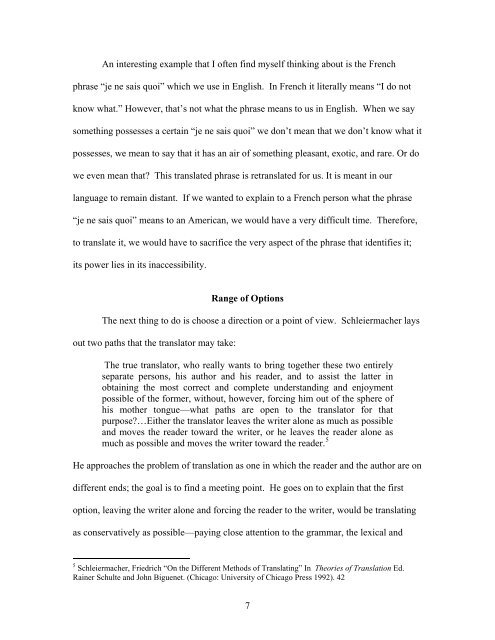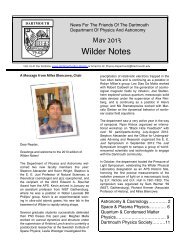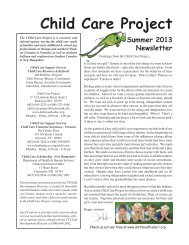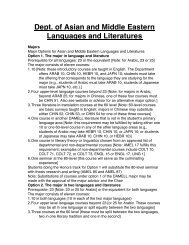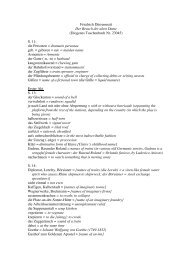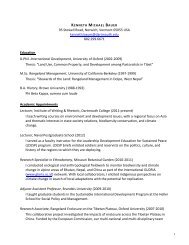A Log Cabin Out of Stone: - Dartmouth College
A Log Cabin Out of Stone: - Dartmouth College
A Log Cabin Out of Stone: - Dartmouth College
You also want an ePaper? Increase the reach of your titles
YUMPU automatically turns print PDFs into web optimized ePapers that Google loves.
An interesting example that I <strong>of</strong>ten find myself thinking about is the French<br />
phrase “je ne sais quoi” which we use in English. In French it literally means “I do not<br />
know what.” However, that’s not what the phrase means to us in English. When we say<br />
something possesses a certain “je ne sais quoi” we don’t mean that we don’t know what it<br />
possesses, we mean to say that it has an air <strong>of</strong> something pleasant, exotic, and rare. Or do<br />
we even mean that? This translated phrase is retranslated for us. It is meant in our<br />
language to remain distant. If we wanted to explain to a French person what the phrase<br />
“je ne sais quoi” means to an American, we would have a very difficult time. Therefore,<br />
to translate it, we would have to sacrifice the very aspect <strong>of</strong> the phrase that identifies it;<br />
its power lies in its inaccessibility.<br />
Range <strong>of</strong> Options<br />
The next thing to do is choose a direction or a point <strong>of</strong> view. Schleiermacher lays<br />
out two paths that the translator may take:<br />
The true translator, who really wants to bring together these two entirely<br />
separate persons, his author and his reader, and to assist the latter in<br />
obtaining the most correct and complete understanding and enjoyment<br />
possible <strong>of</strong> the former, without, however, forcing him out <strong>of</strong> the sphere <strong>of</strong><br />
his mother tongue—what paths are open to the translator for that<br />
purpose?…Either the translator leaves the writer alone as much as possible<br />
and moves the reader toward the writer, or he leaves the reader alone as<br />
much as possible and moves the writer toward the reader. 5<br />
He approaches the problem <strong>of</strong> translation as one in which the reader and the author are on<br />
different ends; the goal is to find a meeting point. He goes on to explain that the first<br />
option, leaving the writer alone and forcing the reader to the writer, would be translating<br />
as conservatively as possible—paying close attention to the grammar, the lexical and<br />
5 Schleiermacher, Friedrich “On the Different Methods <strong>of</strong> Translating” In Theories <strong>of</strong> Translation Ed.<br />
Rainer Schulte and John Biguenet. (Chicago: University <strong>of</strong> Chicago Press 1992). 42<br />
7


